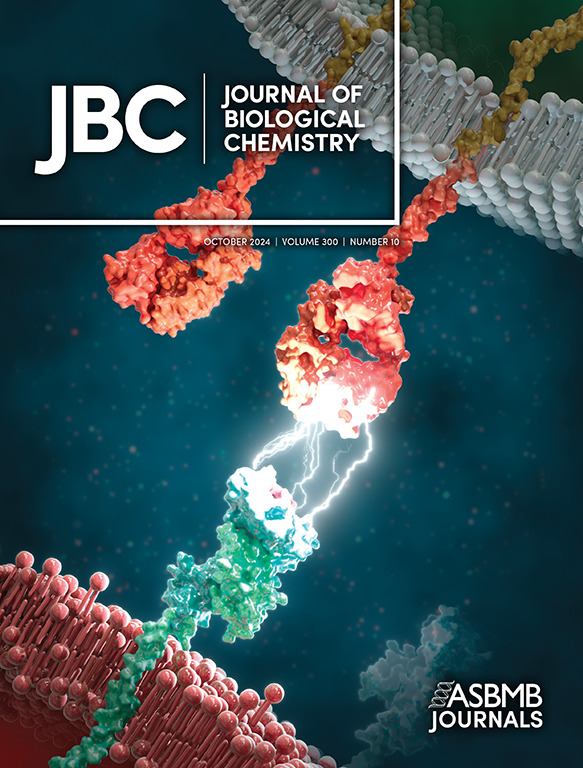The structural characteristics of cellular phospholipid acyl chains required for ABCA1-mediated HDL formation.
IF 4
2区 生物学
Q2 BIOCHEMISTRY & MOLECULAR BIOLOGY
引用次数: 0
Abstract
ATP-binding cassette protein A1 (ABCA1) mediates high-density lipoprotein (HDL) formation by transporting cellular cholesterol and phospholipids to apolipoprotein A-I (apoA-I). Although phospholipids serve as transport substrates for ABCA1 and the membrane constituents surrounding ABCA1, their roles in HDL formation remain unclear. Here, we elucidated the effect of the acyl chain structure of cellular phospholipids on HDL formation, particularly focusing on monounsaturated fatty acid (MUFA)-containing phosphatidylcholine (PC), the predominant phospholipid in most animal cells. PC molecules effluxed to apoA-I had an acyl chain composition similar to cellular PC, both being enriched in MUFA-containing species. Furthermore, manipulating the acyl chain composition of cellular PC by stealoyl-CoA desaturase inhibition or fatty acid supplementation led to similar changes in effluxed PC molecule composition. Thus, ABCA1 can transport various cellular PC molecules, including MUFA-containing species, without apparent preference for their acyl chain structure. Conversely, an appropriate acyl chain composition of cellular phospholipids is required for ABCA1 functional expression. Reducing MUFA content in the cellular phospholipids suppressed ABCA1 expression through two independent mechanisms: first, by inducing an endoplasmic reticulum (ER) stress response that decreases ABCA1 protein production; and second, by causing a folding defect in the ABCA1 protein, leading to immature glycosylation and failure of plasma membrane localization. Excess MUFA supply decreased ABCA1 expression without causing ER stress or defects in glycosylation and localization of ABCA1. Collectively, we revealed the contribution of MUFA-containing PC to HDL formation and identified the structural characteristics of cellular phospholipids required for their transport to apoA-I and functional expression of ABCA1.abca1介导的HDL形成所需的细胞磷脂酰基链的结构特征。
atp结合盒蛋白A1 (ABCA1)通过将细胞胆固醇和磷脂转运到载脂蛋白A-I (apoA-I)介导高密度脂蛋白(HDL)的形成。尽管磷脂作为ABCA1和ABCA1周围膜成分的运输底物,但它们在HDL形成中的作用尚不清楚。在这里,我们阐明了细胞磷脂的酰基链结构对HDL形成的影响,特别是关注含单不饱和脂肪酸(MUFA)的磷脂酰胆碱(PC),这是大多数动物细胞中的主要磷脂。外排到apoA-I的PC分子具有与细胞PC相似的酰基链组成,两者都在含有mufa的物种中富集。此外,通过抑制脂酰辅酶a去饱和酶或补充脂肪酸来控制细胞PC的酰基链组成,导致外排PC分子组成发生类似的变化。因此,ABCA1可以运输各种细胞PC分子,包括含有mufa的物种,而对其酰基链结构没有明显的偏好。相反,细胞磷脂的适当酰基链组成是ABCA1功能表达所必需的。降低细胞磷脂中MUFA含量通过两种独立的机制抑制ABCA1的表达:首先,通过诱导内质网(ER)应激反应减少ABCA1蛋白的产生;二是引起ABCA1蛋白的折叠缺陷,导致糖基化不成熟和质膜定位失败。过量的MUFA供应会降低ABCA1的表达,但不会引起内质网应激或ABCA1糖基化和定位缺陷。总的来说,我们揭示了含有mufa的PC对HDL形成的贡献,并确定了它们转运到apoA-I所需的细胞磷脂的结构特征和ABCA1的功能表达。
本文章由计算机程序翻译,如有差异,请以英文原文为准。
求助全文
约1分钟内获得全文
求助全文
来源期刊

Journal of Biological Chemistry
Biochemistry, Genetics and Molecular Biology-Biochemistry
自引率
4.20%
发文量
1233
期刊介绍:
The Journal of Biological Chemistry welcomes high-quality science that seeks to elucidate the molecular and cellular basis of biological processes. Papers published in JBC can therefore fall under the umbrellas of not only biological chemistry, chemical biology, or biochemistry, but also allied disciplines such as biophysics, systems biology, RNA biology, immunology, microbiology, neurobiology, epigenetics, computational biology, ’omics, and many more. The outcome of our focus on papers that contribute novel and important mechanistic insights, rather than on a particular topic area, is that JBC is truly a melting pot for scientists across disciplines. In addition, JBC welcomes papers that describe methods that will help scientists push their biochemical inquiries forward and resources that will be of use to the research community.
 求助内容:
求助内容: 应助结果提醒方式:
应助结果提醒方式:


